 Features
Features

Doctors at the National Children’s Hospital performed 60 surgeries last year on patients suffering these types of heart defects, with a success rate of 96.7 per cent.
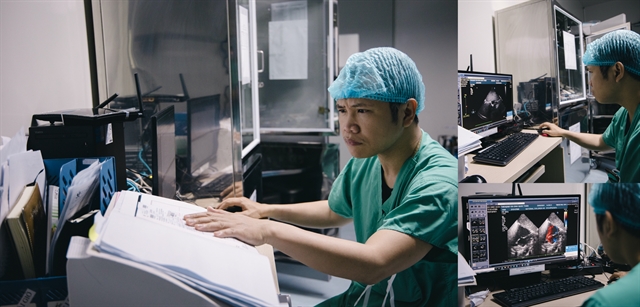
|
| IN PREPARATION: Dr Nguyễn Lý Thịnh Trường goes through Quốc Thiên’s medical records. VNA/VNS Photo Minh Sơn |
By Minh Sơn
The hardest time in the lives of the young couple may never have ended if their infant child didn’t survive that afternoon.
At about 3pm one day last February, Đỗ Văn Lượng, 35, from the northern province of Bắc Giang, clung tightly to his four-day-old son for the final time before leaving him with the medical staff.
In just a few minutes, his son, Quốc Thiên, would enter into a life and death struggle at the National Children’s Hospital (NCH).
He was ready for Transposition of the Great Arteries (TGA) surgery, one of the most complicated heart operations, especially for new-borns.
The infant had a heart deformity related to the arterial stem, a particularly dangerous condition for infants when not treated in time.

|
| HOLDING TIGHT: Đỗ Văn Lượng and his four-day-old son Quốc Thiên just before the surgery. VNA/VNS Photo Minh Sơn |
Dr Nguyễn Lý Thịnh Trường, director of the Heart Centre (CHC) at the NCH, and his colleagues carefully prepared for the surgery and were ready to do everything to save the little boy.
The father said that although he was upset and anxious, he felt relieved after being told that the operation would be conducted by a team headed by one of the leading doctors in children’s heart surgery.
He learned that Dr Trường is an expert in handling rare cases like his son.
Little Thiên was diagnosed with TGA disease when he was still in his mother’s womb, and Lượng had come down to Hà Nội from Bắc Giang with his wife to the National Hospital of Obstetrics and Gynaecology.
His wife was yet to see their child, as he had been immediately taken to the NCH.
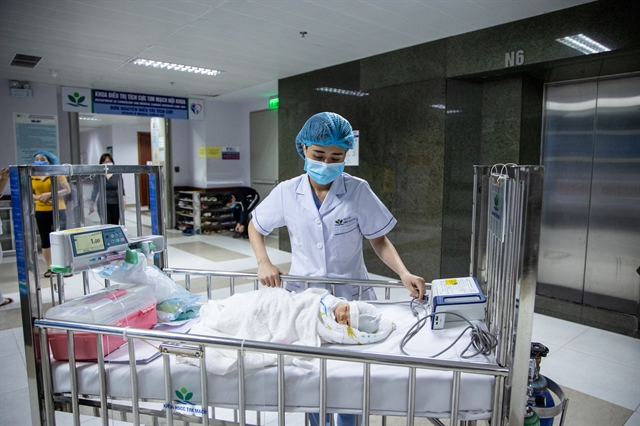
|
| WATCHFUL EYE: A nurse cares for Thiên just before he enters the operating room. VNA/VNS Photo Minh Sơn |
Although he had handled many such cases, this was only perhaps the second time he had seen such a condition.
“This case was especially difficult,” he said. “A deviation of only one-third or half a millimetre will affect his life, because the coronary artery’s job is to supply almost all of the heart’s blood.”
According to the doctor, the diameter of a coronary artery in a new-born is only about 1-1.5mm, which is not even visible to the naked eye, so doctors use a magnifying glass to perform the surgery. The permissible deviation is only about 0.2-0.5mm.
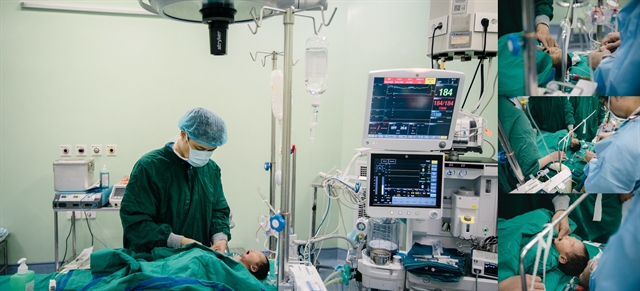
|
| TOGETHER AS ONE: A 10-member surgical team - including five doctors and five nurses - perform the surgery. VNA/VNS Photo Minh Sơn |
There are hundreds of patients needing TGA surgery as soon as possible, but Dr Trường said Thiên’s case was difficult since the position of the coronary artery was abnormal.
Most babies in this condition undergo TGA surgery within their first month of life, but there are some who need it within two weeks.
“If the surgery is successful, the baby will go on to lead a normal life,” the doctor said.
However, he added, it was important to take special care of such children and attend periodic examinations, as patients with other congenital heart diseases must do. A few patients will need a second operation at some point in their lives.
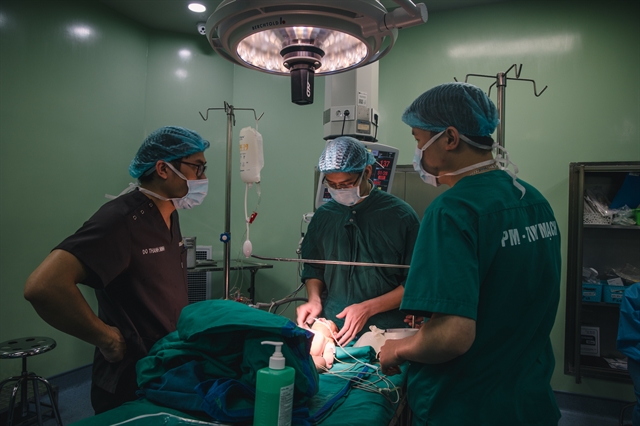
|
| UNDERWAY: A moment during the operation. VNA/VNS Photo Minh Sơn |
TGA is a serious heart defect that occurs before birth. It causes a change in the blood circulation throughout the body, resulting in a lack of oxygen in the blood when it leaves the heart. The little patients may face severe complications or even death if not diagnosed and treated quickly.
“Arterial transfer disease may be found before birth or from the first hours to weeks after birth,” Dr Trường said, adding that this was the 581st TGA surgery performed at the NCH. “It is a complicated and serious congenital heart disease that often requires surgery in the first month after birth.”
“If not detected in time, 80-90 per cent of babies will die in the first year. And they cannot undergo surgery after they are two or three months old.”
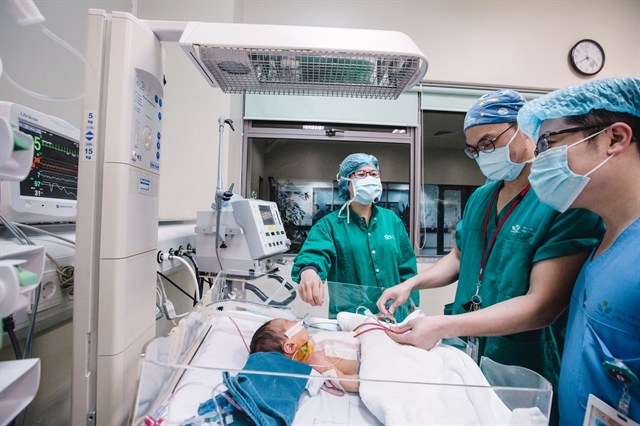
|
| SUCCESS: The operation concludes after more than five hours. VNA/VNS Photo Minh Sơn. |
The doctor has made a significant contribution to the success of the CHC in treating children’s heart conditions.
Since 2016, when he became director of the centre, the number of heart surgeries has nearly tripled, from about 500 to 1,453 a year. More than 30 per cent of those are performed by Dr Trường.
At times he may perform four such surgeries in a single day, with him finally putting the scalpel down well into the evening.
A report from the NCH put its success rate for surgery on complicated congenital heart disease at over 93 per cent. Doctors performed 60 surgeries last year on patients suffering these types of heart defects, with a success rate of 96.7 per cent.
It is an encouraging rate for Việt Nam and even outpaces the figure of 90 per cent in other Southeast Asian countries like Singapore, Malaysia, and Thailand.
The CHC performed surgery on about 1,660 patients last year, of which 1,650 had complex heart defects.
Prior to 2010, a majority of paediatric patients with such defects died, as surgery in Việt Nam was impossible and heading overseas wasn’t an option for most people.
Recent figures show that the rate of children with cardiovascular disease in Việt Nam is about 1-1.5 per cent. Of these, 60 per cent need surgical intervention, and 80 per cent of those go on to lead a healthy life. Surgery is the only treatment for complicated congenital heart disease, because without direct intervention the risk of death within the first week of life is about 30 per cent and almost 100 per cent within a year.
The surgical process is divided into several stages and include the administration of anaesthesia, stopping the heartbeat, running an artificial heart machine, the actual surgery, and then active resuscitation.
Dr Trường said making the heart stop beating is the most difficult, as even the smallest of mistakes can have terrible consequences.
To ensure the heart functions as normal post-operation, doctors must relocate both the aorta and the pulmonary artery. The most complex part is repositioning the coronary arteries, which are only about 0.5mm in diameter, meaning absolute precision is needed.
Other heart defects are also addressed during the surgery.
About a decade ago, TGA struck fear into the parents of new-borns diagnosed with the condition.
Now, though, at the CHC, the disease can be treated effectively thanks to talented surgeons, advancements in diagnosis and treatment, and, especially, the centre’s post-surgery care.
A complex operation such as TGA now takes four or five hours, whereas in the past it was anywhere between half a day or even more than a day.
Not only little Thiên but also hundreds or even thousands of other new-borns suffering from congenital heart diseases will survive in the future, thanks to advancements in medicine and healthcare in Việt Nam.
The TGA surgeries performed at the CHC affirm that the professionalism of Vietnamese doctors and medical staff is at least the equal of those in the region and the world, filling people with confidence that even the most severe condition can now be treated right here at home. VNS




